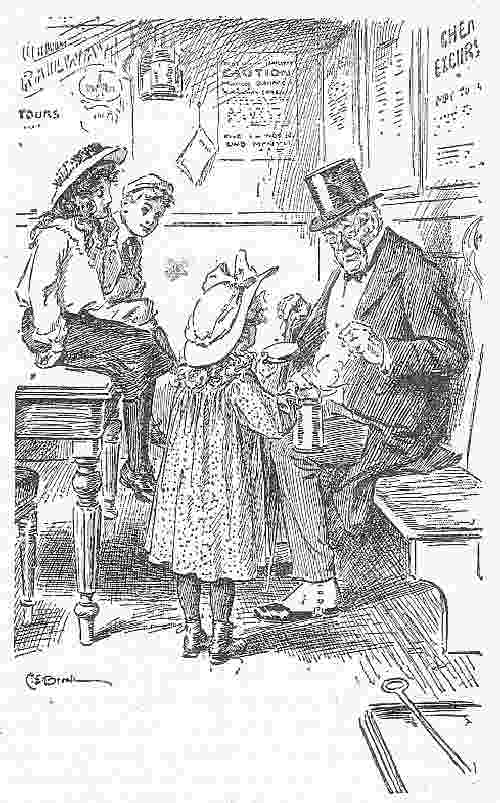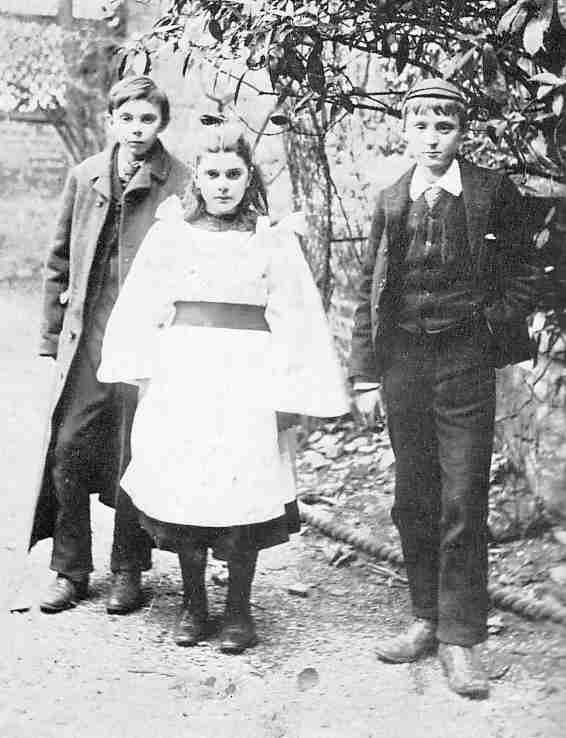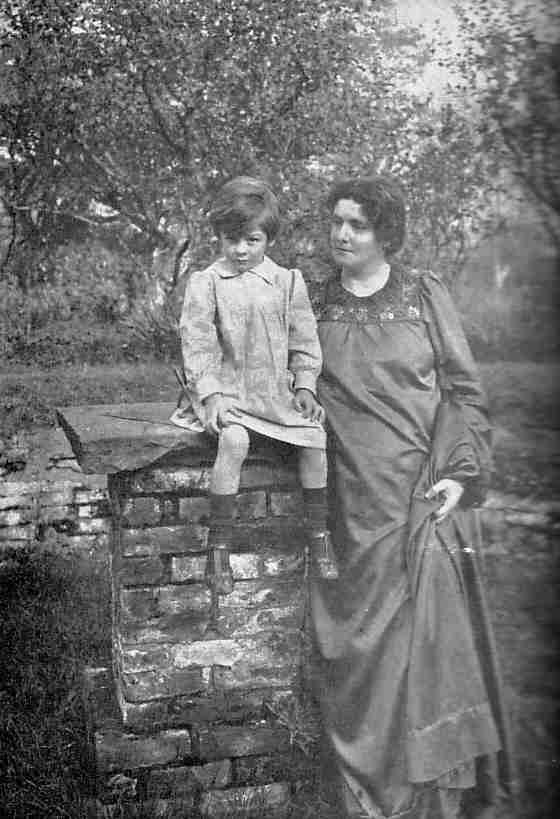
Figure 1.--This illustration shows the three children who are the central characters in "The Railway Children". The youngest child is serving tea in the railway waiting room. The illustrator appears to be C.E. Break.


Figure 1.--This illustration shows the three children who are the central characters in "The Railway Children". The youngest child is serving tea in the railway waiting room. The illustrator appears to be C.E. Break. |
Edith Nesbit was the the daughter of John Collis Nesbit, a school teacher. She was born into a very conservative family in 1858. Her father ran schools in Bradford, Manchester and London as well as agricultural schools. He died when Edith was very young, only 6 years old. This cause financial problems for the family as their father was the principal bread earner. Edith was unhappy at an English boarding school. Edith's mother took her to the Continent where she was eduicated in French and German schools--an expensive proposition. Edith began publishing poems when they returnd to England. It was at this time when she was about 19 years of age that she met Hubert Bland, a radical young writers, who radicalized Edith's more convential social values. Edith In 1879 became pregnant with Bland's baby which was born only 2 months after they were married on April, 22, 1880. This was quite a scandal in Victorian England. Edith and Hubert were devoted socilaists and in 1883 with a Quaker friend, Edward Pease, formed a debating groupthat they named the Fabian Society. Bland was elected treasurer and Nesbit and Bland jointly edited the society's journal, Today. Soon imporant socialists in London began attending Fabian meetings, men like George Bernard Shaw. Edith in 1885 named her second child Fabian. Alice Hoatson, the assistant secretary of the Fabian Society, moved into Nesbit and Bland's home and soon gave birth to Bland's baby, Rosamund. Many Socialists in the 19h century also rejected conventional morality. Edith appears to have acquised in the situation and, at any rate, raised Rosamund as her own child. They moved in bohemian circles. Edith herself was quite a striking woman. One contemprary writes, "She was a very tall woman, built on the grand scale, and on festive occasions wore a trailing gown of peacock blue satin with strings of beads and Indian bangles from wrist to elbow." She also smoked at a time that it was not considered proper for a woman. Nesbit and Bland in 1885 experimented wity the Social Democratic Federation. However, but rejected its leader H. H. Hyndman as too radical. Nesbit was a an active lecturer and prolific writer on socialism during the 1880s. Her political activities, however ebbed as she achieved success as a children's writer. Her socilaist books were often signed Fabian Bland. Her children's books we signed "E. Nesbit" as women writers were still not fully acceopted. Julia Briggs, Nesbit's biographer claims that she was "the first modern writer for children". Her most famous books include The Story of the Treasure-Seekers (1899), The Wouldbegoods (1901), Five Children and It (1902), The Pheonix and the Carpet (1904), The New Treasurer-Seekers (1904), The Railway Children (1906) and The Enchanted Castle (1907). It is The Railway Children that she is best remembered for today. In it the family has to fend for themselves without their father, certainly in part autobiographical. Her radical politics is not obvious in her books which depict very conventional morality. She does, however, deal with the problems encountered by real children and not the fantasy stories of writers like Lewis Carol. The best example of this is the difficult lives faced by The Railway Children. Bland died in in 1914. Edith then married Thomas Tucker, an engineer. Nesbit continued to write children's books. She published 44 books in all. She also wuote poetry. She died in 1924.
Edith Nesbit was the the daughter of John Collis Nesbit, a school teacher. She was born into a very conservative family in 1858. Her father ran schools in Bradford, Manchester and London as well as agricultural schools.
Edith's father died when she was very young, only 6 years old. This cause financial problems for the family as their father was the principal bread earner. This is depicted in some of her books like The Railway Children.
Edith was unhappy at an English boarding school. Edith's mother took her to the Continent where she was eduicated in Fraench and German schools--an expensive proposition.

Figure 2.--Here is Paul Bland and two Nesbit cousins. I am not sure which boy is Paul. This photograph looks to have been taken about 1890. A reader tells us that Paul was Nesbit's second son. |
Edith began publishing poems when they returnd to England. It was at this time when she was about 19 years of age that she met Hubert Bland, a radical young writers, who radicalized Edith's more convential social values. Edith In 1879 became pregnant with Bland's baby which was born only 2 months after they were married on April, 22, 1880. I think this was Paul, but am not sure. This was quite a scandal in Victorian England.
Edith and Hubert were devoted socilaists and in 1883 with a Quaker friend, Edward Pease, formed a debating group that they named the Fabian Society. Bland was elected treasurer and Nesbit and Bland jointly edited the society's journal, Today. Soon imporant socialists in London began attending Fabian meetings, men like George Bernard Shaw.
The children involved in Edith's wife is a complicated story. Edith had three children. They were Paul, Iris and Fabian. [McCarthy] Edith had her first child in 1880. She named her second child in 1885 Fabian. Fabian fied at a young age (1900). There were two other children that Alice Hoatson had with Edith's husband Herbert Bland, John and Rosamund. We have few details at this time in how she raised them or hiow they were dressed. The photograph of Paul with his cousins suggest that they were dressed in standard late Victorian outfits. Notice the Eton collar (figure 2). I'm not sure just what the girl is wearing, perhaps a smock over a dress. A portrat of Nesbit with John shows him wearing a smock.
Alice Hoatson, the assistant secretary of the Fabian Society, moved into Nesbit and Bland's home. In fact Bland had been seeing Alice as long as he knew Edith. Soon Alice gave birth to Bland's baby, Rosamund. Many Socialists in the 19h century also rejected conventional morality. Edith appears to have acquised in the situation and, at any rate, raised Rosamund as her own child.
The Blands moved in bohemian circles. Edith herself was quite a striking woman. One contemprary writes, "She was a very tall woman, built on the grand scale, and on festive occasions wore a trailing gown of peacock blue satin with strings of beads and Indian bangles from wrist to elbow." She also smoked at a time that it was not considered proper for a woman.
Nesbit and Bland in 1885 experimented wity the Social Democratic Federation. However, but rejected its leader H. H. Hyndman as too radical. Nesbit was a an active lecturer and prolific writer on socialism during the 1880s.

Figure 3.--Here is Edith with John Brand. He was her husbands son by another relationship. I'm not sure when the photograph was taken, but it looks like the 1890s. John looks to be wearing a smock. |
Nesbit's political activities, however ebbed as she achieved success as a children's writer. Her socilaist books were often signed Fabian Bland. Her children's books we signed "E. Nesbit" as women writers were still not fully acceopted. Julia Briggs, Nesbit's biographer claims that she was "the first modern writer for children". Her bohemian-socialist background is not what you expect for a writer of children's books. I'm not sure how well known her life style was among the Victorian parents who purchased her books for their children. Her most famous books include The Story of the Treasure-Seekers (1899), The Wouldbegoods (1901), Five Children and It (1902), The Pheonix and the Carpet (1904), The New Treasurer-Seekers (1904), The Railway Children (1906) and The Enchanted Castle (1907). It is The Railway Children that she is best remembered for today. In it the family has to fend for themselves without their father, certainly in part autobiographical. Her radical politics is not obvious in her books which depict very conventional morality. She does, however, deal with the problems encountered by real children and not the fantasy stories of writers like Lewis Carol and J.M. Barry. This realism is her socialism showing through, but without the dialectic.. The best example of this is the difficult lives faced by The Railway Children.
Peter, Phyllis and Roberta are brother and sisters and the three main characters of The Railway Children. The book is set in southern and northern England. Initially they were "ordinary suburban childern" as the novel puts it, their father accused of a crime he did not commit is jailed at the beginning of the story. The loss of income from this causes the family to have to dismiss the maid and move into the country side in the north. They have to scrimp and make do when their father is accused of a crime and locked up. They move to a home near the railroad tracks and ger to know the railroad workers. This if course leads to many splendid adventures.
I'm not sure at this time who illustrated Nesbit's childrens' books. The charming illustrations in The Railway Children were done by C E Brock. We do not know if Nesbit specifically chose him or if he was chosen by the publisher.
Bland died in in 1914. Edith then married Thomas Tucker, an engineer. Nesbit continued to write children's books. She published 44 books in all. She also wrote poetry. She died in 1924.
McCarthy, Margaret. Chairman, The Edith Nesbit Society, e-Mail, July 14, 2005.
Navigate the HBC literary pages' Historical Clothing Web Site:
[Return to the main Main English children's author page]
[Return to the main Main English children's literary page]
[Return to the main Main literary page]
Navigate the Boys' Historical Clothing Web Site:
[Introduction]
[Activities]
[Biographies]
[Chronology]
[Clothing styles]
[Countries]
[Bibliographies]
[Contributions]
[FAQs]
[Glossaries]
[Satellite sites]
[Tools]
[Boys' Clothing Home]
